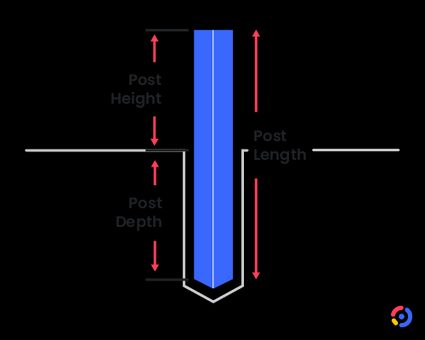Fence Post Depth Calculator
Table of contents
How to calculate the ideal depth for your fence postsHow to use this fence post depth calculatorExample: 6-foot chain link fence post depthFence post depth chartWhat to take into account when digging a hole for a post?Installing a fence can be daunting, but that's no longer the case thanks to the fence post depth calculator. Our tool will help ensure your fence posts are installed correctly and safely with the perfect measurements for the depth of the hole for the fence posts.
It considers the fence's above-ground height and helps you calculate the ideal depth for your fence in the blink of an eye. Be sure to also check the fence material calculator or vinyl fence calculator if you want to prepare yourself for the fencing.
How to calculate the ideal depth for your fence posts

Before we start digging, we need to calculate the depth of the hole for the fence post. To do this, you'll need to take a number of parameters into account:
- The height of your fence.
- The size of the fence posts.
- The nature of the soil.
We can now determine the hole size based on these factors.
The minimum depth for the fence post should be at least 1/3 of the post's above-ground height. The deeper the holes, the more stable the fence, but you must buy longer posts. But if you want more information on how much it costs to build a fence, you can take a look at our fence material estimator.
So that you know, here are the equations to determine the perfect holes and lengths for your fence posts.
or
How to use this fence post depth calculator
Using this fence post depth calculator is very straightforward. All you have to do is:
- Enter your desired fence height.
- Then, you will obtain the perfect depth of the hole for the fence post you must dig.
- You will also see the total length of the post you must purchase.
There's no real consensus on exactly how deep a post should be buried. Some say that the concealed part of the post should be equal to at least 1/3 (0.33) of the above-ground portion. Others say 2/5 (0.40). The only thing we know for sure is that the minimum depth for the fence post is at least 1/3 of the post height. This is why we have allowed the option to change the depth-to-height ratio in the calculator. You can change the ratio's 0.33 default value to whatever you prefer.
Example: 6-foot chain link fence post depth
Let's look at an example to make calculating the depth of your posts' holes even more straightforward.
Let's say you want to know a 6-foot chain link fence post depth. Let's consider that the holes should be about of the total height of the post and that your fence is 6 feet high.
The hole for each post should be at least 1.98 feet deep.
Thus, your posts must be about 7.98 feet long.
💡 Here are some additional tips to keep in mind when using our fence post depth calculator:
- Buy posts that are a few inches or centimeters longer than the calculated length in case of mistakes or unexpected events.
- Make sure you dig holes that are straight and even.
- Fill the holes with concrete or cement to fix the fence posts in place. You can even check our post hole concrete calculator to help you.
Fence post depth chart
You're so eager to start your new fence that you don't even have time to enter your measurements in our calculator. Don't worry. We've got you covered!
Check out our fence post depth chart to get an idea of the dimensions you may need for your project.
Post height | Post depth | Post length | |||
|---|---|---|---|---|---|
feet | meters | feet | meters | feet | meters |
3.5 | 1.07 | 1.16 | 0.36 | 4.66 | 1.42 |
4 | 1.22 | 1.32 | 0.41 | 5.32 | 1.63 |
5 | 1.53 | 1.65 | 0.51 | 6.65 | 2.04 |
5.6 | 1.71 | 1.85 | 0.57 | 7.45 | 2.28 |
6 | 1.83 | 1.98 | 0.61 | 7.98 | 2.44 |
All values have been calculated with the ratio's default value.
💡 Reminder:
What to take into account when digging a hole for a post?
As we saw briefly above, a number of factors will influence the hole size to set the post. When digging your post holes, you shouldn't forget the stresses each post must withstand:
-
The nature of the soil. Loose, sandy soil will bear less load than hard, rocky soil.
-
The wind! This is often underestimated. You need to consider the environment so that gusts of wind don't blow over your fence.
-
The type of fence: A very open-work fence will require less strength to hold it in place than a solid fence, which won't let the wind through freely.
Now that you are confident, thanks to the fence post depth calculator, that your posts will be buried at the proper depth, you may also want to consider the diameter of your fence posts.
Therefore, if you want to dig further into fence-related subjects, look at our very complete fence calculator!
